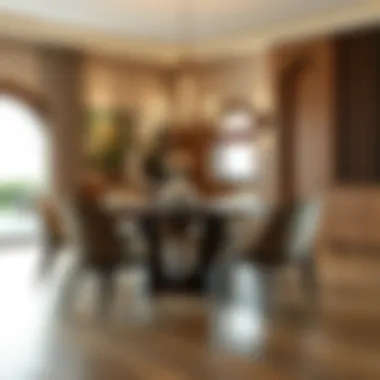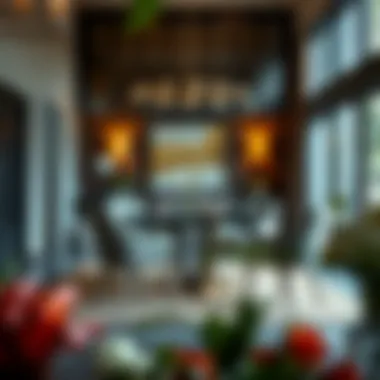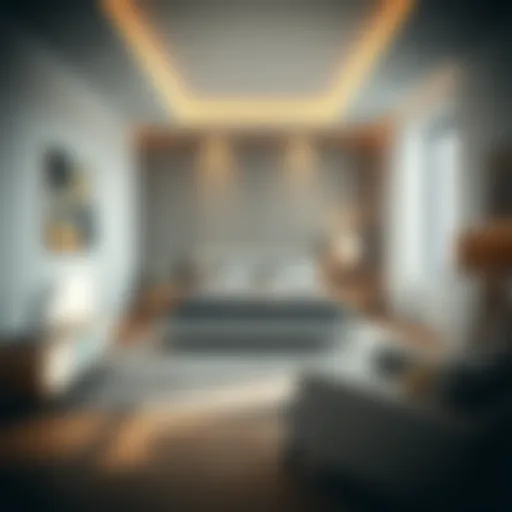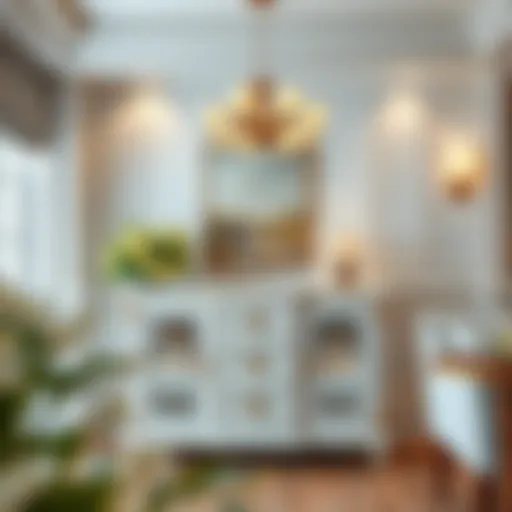The Versatile Appeal of Round Dining Tables and Chairs


Intro
When it comes to designing a dining space that balances both functionality and aesthetic appeal, round dining tables paired with six chairs stand out as a remarkable choice. This article takes you on a journey through their versatility, exploring how these tables are not just furniture but key components that shape the ambiance of a home. We’ll delve into various styles and trends, care tips, and the social dynamics fostered by the circular design. The goal is simple: to offer insights for homeowners, designers, and enthusiasts aiming to create a welcoming dining experience that resonates with their lifestyle.
Furniture Styles and Trends
Modern vs. Traditional: Understanding the Aesthetics
In the realm of interior design, round dining tables can seamlessly fit into both modern and traditional settings. Think of the modern minimalist aesthetic, often characterized by clean lines and uncluttered spaces. Here, a sleek, glass-top round table complemented by metallic chairs provides an elegant yet understated look.
In contrast, traditional settings might favor a sturdy wooden table, perhaps with intricate carvings. Here, the warmth of wood creates an inviting atmosphere that encourages long meals and lively conversation.
"Choosing the right style for your round dining table means considering not only your personal taste but also how it interacts with your living space."
Color and Material Trends: What's In and What's Out
Consideration of color and material is paramount when selecting the right round dining table. Currently, earthy tones like terracotta and soft greens are trending, reflecting a desire for nature-inspired decor. In terms of materials, sustainable choices like bamboo are in vogue, appealing to eco-conscious consumers. On the other hand, materials such as reclaimed wood are gaining traction, marrying tradition with sustainability.
Conversely, stark whites and grays may have seen their heyday, as homeowners increasingly embrace warmer, more diverse palettes. The aesthetic not only impacts the visual appeal but also dictates how the dining space feels. A round table in a soft beige can create a cozy and welcoming environment, perfect for gatherings.
Furniture Care and Maintenance
Tips for Prolonging the Life of Your Furniture
Having invested in a round dining table and six chairs, keeping them in tip-top shape is essential. Here are essential tips to ensure longevity:
- Regular Cleaning: Dust your table and chairs regularly to prevent scratches and grime buildup. A soft, damp cloth works wonders.
- Protect Against Sunlight: Direct sunlight can warp and fade your furniture, so consider placing your dining area away from the windows or using protective covers.
- Use Coasters and Placemats: These simple items can greatly reduce wear and tear from food and drinks.
DIY Repair Hacks for Common Furniture Issues
Even the finest furniture faces wear and tear over time. For scratches, a simple home remedy involves mixing equal parts of olive oil and vinegar, then applying it to the affected area with a soft cloth. For minor dents, gently rubbing the area with a damp cloth and applying heat from an iron can sometimes bring the wood grain back to life. Simple DIY fixes can provide a quick and economical way to address common issues.
Prologue to Round Dining Tables and Six Chairs
The choice of dining table is a pivotal one for any home. It holds a firm spot at the heart of daily life — from bustling breakfasts to leisurely dinners with friends. Among the various shapes available, round dining tables paired with six chairs stand out for their unique charm and practicality. This article delves into the values these tables and seating arrangements bring to your dining experience, illuminating their multi-faceted benefits, considerations, and design aspects that might guide your selection process.
The Significance of Dining Spaces
Dining spaces are more than just places to eat; they serve as a backdrop for connection and community. They encourage conversations that flow easily, cultivate family traditions, and foster relationships. In today’s fast-paced world, carving out time to share meals is more vital than ever. A well-defined dining area takes on the role of a gathering hub. A round table with six chairs enhances this by offering an intimate yet inclusive setup.
Round tables invite everyone present into the heart of the dialogue, eliminating the barriers often felt with rectangular or square ones. Each guest can feel equally engaged, as the shapes naturally promote eye contact and unified interaction. This informal atmosphere nurtures relationships and enhances the enjoyment of mealtime.
Moreover, the configuration of six chairs allows for additional flexibility. It accommodates families of various sizes, as well as the occasional friend dropping by for dinner. Whatever the case, these tables facilitate a warmth and inclusivity that's hard to duplicate.
Choosing the Right Table Shape
Selecting the correct table shape might seem trivial but bears significant weight on the overall dining experience. Practical considerations often intersect with aesthetics in this choice. Round tables, in particular, are remarkably versatile. They can fit into tighter spaces without cramping a room’s style, making them a popular choice in both small and spacious homes alike.
When facing the task of choosing the right shape, consider the following factors:
- Space Dimensions: Assess the area where the dining table will reside. Round tables can often allow for easier navigation, while their size can be adjusted to match the dimensions of a room, keeping it balanced and unstuffy.
- Usage Frequency: How often do you host guests? A round table generally accommodates more people very comfortably compared to rectangular ones which tend to have fixed boundaries.
- Style Compatibility: Your dining table should complement existing decor. Round shapes often harmonize well with a wide range of styles from contemporary to classic, enabling a cohesive look.
In our exploration of round dining tables and six chairs, we will further engage with their materials, styles, and functional attributes to help tailor your dining area into a space that reflects both comfort and style.
Design Elements of Round Dining Tables
When delving into the world of round dining tables, the design elements play a crucial role not just in aesthetics but also in functionality. These elements determine how well the table merges with your overall dining area, reflecting both personal style and practical needs.
Material Options
Wood
Wood, ah, the classic choice. It's timeless and brings a warmth that other materials often miss. One reason wood stands out is its durability, meaning it can last for years if cared for. The natural grains and textures give each piece a unique character, making your dining space feel personal.
However, wood can be susceptible to moisture and scratches. So, while it looks great, some might find the maintenance a headache. But for those who appreciate the beauty of natural finishes, the advantages often outweigh the downsides.
Metal
Metal offers a sleek, modern vibe that's hard to beat. It's sturdy and perfect for those who prefer a minimalist look. Metal tables often come with striking designs, adding an edge to your dining space that is hard to achieve with wood. Moreover, they are resistant to moisture and staining, offering peace of mind during messy dinners.


That being said, metal can get cold and uninviting. However, pairing it with warm chairs can help counterbalance that sterility. Metal has its followers, especially in urban lofts or contemporary homes.
Glass
There's something about a glass table that creates an airy and sophisticated atmosphere. It can make any space seem larger than it is, which is a massive benefit for those with limited square footage. Glass tops often show off the base underneath as well, allowing for a unique blend of design elements.
Yet, it can be prone to fingerprints and requires a bit more cleaning. Moreover, careless handling can lead to scratches. Still, for many, the elegance of glass is worth the extra effort.
Style Variety
Modern
Modern round tables often feature clean lines and innovative materials. This style leans towards simplicity, focusing on function while making a striking design statement. The versatility of modern designs means they're easily adaptable to various settings, whether a chic urban apartment or a cozy suburban home.
Traditional
Traditional designs evoke a sense of richness and history. A traditional round table often incorporates intricate woodwork or ornate details, giving it a timeless allure. It fits well in classic homes or anyone looking to create a warm, inviting dining atmosphere. The challenge, however, is that they require more space due to their extensive detailing.
Rustic
When you think of rustic, think of charm and natural beauty. Rustic tables often come from reclaimed wood, giving them a story and a unique character. Perfect for a cottage or a casual dining space, these tables invite everyone to gather and enjoy. They may not fit in highly modern settings as cohesively, but they shine in laid-back environments.
Size Considerations
Standard Dimensions
When considering round tables, it's vital to note their standard dimensions. They come in various sizes, typically ranging from 36 inches to 60 inches in diameter. This variety allows for flexibility in seating arrangements. A 48-inch table comfortably seats six, making it a popular choice for families or gatherings.
Space Requirements
The space around the table is just as important as its size. You should allow a good 36 inches around the table for easy movement of chairs and guests. This space requirement is often overlooked but is critical to ensure comfort while dining. If the layout lacks space, it might feel claustrophobic, which no one enjoys during a meal.
By understanding these design elements, you can choose a round dining table that enhances your space's beauty and functionality, aligning with your personal style and lifestyle needs.
Functional Advantages of Round Tables
Round dining tables come with a unique set of advantages that cater to the diverse needs of homeowners and designers alike. Their inherent structure makes them not just a piece of furniture, but a facilitator of experiences and relationships in the dining space. The essence of a round table goes beyond aesthetics; it offers a strategic approach to space utilization, enhances social interaction, and allows for creative freedom in design.
Facilitating Conversation
Round tables naturally promote a more inclusive atmosphere, making them ideal for lively dinner parties or intimate family gatherings. The absence of corners encourages everyone to connect and engage. People sitting around a round table can easily see one another, breaking down barriers that rectangular tables might impose. This setup makes it easier to initiate conversations and ensures that no single person feels isolated.
With a round dining table, it's like being brought into the circle. This approach can foster a relaxed environment, allowing for laughter and storytelling to flow freely. When hosting gatherings, the inviting shape of a round table can lead to deeper discussions and connections amongst guests. Think about how sharing stories over a meal becomes effortless.
Maximizing Space Efficiency
In terms of functionality, round tables excel at maximizing space, an essential consideration in modern homes with open floor plans. The compact design allows these tables to fit comfortably into various spaces, from cozy nooks to expansive dining rooms. Their shape can squeeze into tighter spots without sacrificing the usability of the area. When chairs are pushed in, the rounded edges prevent harsh lines that can make a room feel cramped.
Another point to consider is that there are no corners to hinder movement. This characteristic is especially beneficial for families with children or guests with mobility challenges. Notably, round tables can often come with extendable options, further accommodating unexpected guests. The ability to expand when needed and contract when not in use illustrates the flexibility of round dining tables, adapting to everyday life without fuss.
Flexibility in Design
Round dining tables offer immense flexibility in design, complementing a multitude of interior styles—from sleek modern to charming rustic. Because of their shape, they can serve as a stunning centerpiece that draws the eye and complements surrounding decor. Homeowners can dress them with various table settings, linens, or centerpieces to create an ambiance that mirrors the occasion.
The blend of diverse materials, such as wood, glass, or metal, allows for an endless combination of styles and finishes. Users can easily match a round table with their six chairs when emphasizing cohesion, or choose to experiment with contrasting designs for an eclectic flair. As home design trends evolve, round tables adapt seamlessly, providing a canvas for creativity and self-expression in the dining area.
In summary, the functional advantages of round tables unfold a wealth of possibilities. They transform the dining experience by enhancing conversation, efficiently utilizing space, and allowing for design adaptability. For those looking to create a dining area that resonates with warmth and togetherness, a round table paired with six carefully chosen chairs represents an excellent choice. It's not just about sitting down to eat; it's creating a space where memories and connections are forged.
Choosing Six Chairs for Your Dining Table
Selecting the right chairs to accompany your round dining table is essential for creating a dining area that is both functional and visually appealing. Six chairs create an inviting atmosphere, especially for gatherings, and they should complement the table while meeting various needs. When choosing, keep in mind how the chairs enhance not just the table itself but the overall ambiance of the room. Each chair must align with your personal style while addressing several key considerations that impact both comfort and usability.
Matching Styles and Colors
The aesthetic harmony between your round dining table and chairs can make or break the visual appeal of your space. Consider a few elements when matching styles and colors. It’s essential to select chairs that either share a similar design language with the table or create a deliberate contrast that adds interest.
- Color Coordination: Sticking to a color palette is a must. If your table is a rich, dark wood, chairs in lighter shades can brighten the area without overpowering it. Conversely, sleek metal chairs can add a modern touch to a classic wooden table.
- Material Consistency: Mixing materials can yield stunning results. A glass or marble table can work beautifully with wooden or upholstered chairs, creating a layered look that feels rich and inviting.
- Style Compatibility: Choose chairs that reflect the overall style of your dining space—be it mid-century modern, farmhouse, or minimalist. For instance, if the table is contemporary, you might opt for chairs with clean lines and contemporary fabric, keeping the vibe cohesive.
Comfort and Ergonomics
Comfort is paramount when it comes to chairs, especially those intended for prolonged use during family meals or entertaining guests. Consider these aspects:


- Height and Proportion: The height of the chairs should align with the table. Ideally, there should be enough elbow room for diners, which usually translates to around 10-12 inches between the seat and the tabletop. This height ensures comfortable seating without feeling cramped.
- Cushioning and Back Support: Look for chairs with ample cushioning, especially if long dinners are the norm. Ergonomically designed chairs that provide good back support can enhance dining experiences and keep guests comfortable.
- Test Before You Buy: If possible, try sitting in the chairs before making a purchase. A chair might look fantastic, but without testing, you can’t be sure how it feels for long periods.
Durability and Maintenance
Investing in durable chairs is crucial, especially for households with kids or frequent gatherings. Consider the following:
- Material Choices: Chairs made from solid wood, metal, or high-quality plastic tend to endure wear and tear better than cheaper alternatives. Upholstered chairs might need more frequent cleaning, so consider stain-resistant fabrics if spills are a concern.
- Finish and Coating: If choosing wooden chairs, look for those with finishes that resist scratching and can be wiped clean easily. For metal chairs, a powder-coated finish can protect against rust and wear, ensuring longevity.
- Regular Maintenance: Chairs that require minimal upkeep are ideal. Regularly checking for loose screws or wobbling legs can help prolong their life and maintain an appealing look.
Durable furniture isn’t just about looks; it’s about choosing pieces that withstand the test of time and use, ensuring your dining area remains an inviting and functional space for years to come.
Choosing six chairs for your round dining table is a balancing act of style, comfort, and durability. Carefully consider how each element influences the others, creating a space that’s not only functional but also a reflection of your personal taste and lifestyle. With the right chairs in place, your dining area can transform into a warm and welcoming setting for both everyday meals and special occasions.
Setting Up Your Dining Area
Setting up your dining area is more than just placing a table and chairs in the middle of the room. It’s about curating an atmosphere that promotes comfort and social interaction while accommodating the practical needs of those who dine there. In this section, we will explore various elements that contribute to an inviting dining space, focusing on layouts and lighting.
Optimal Layouts
A well-thought-out layout can significantly impact the overall dining experience. Utilizing the space efficiently and giving a smooth flow not only enhances functionality but also creates an inviting backdrop for gatherings.
Centered Arrangement
The centered arrangement is a classic choice for dining setups, as it naturally draws people toward the table, creating a focal point. It’s particularly advantageous when hosting dinner parties or family meals. This configuration makes it easy for diners to engage in conversation while ensuring everyone feels included and connected.
Key characteristics of centered arrangements include:
- Balanced Accessibility: All diners have equal access to the table, making it easier to serve food.
- Aesthetic Appeal: Visually, a centered table creates a feeling of symmetry, making the whole area look polished.
- Diverse Use: This arrangement is versatile, easily adaptable for both casual dining and formal gatherings.
However, one must consider the space available. A centered arrangement can sometimes feel cramped in smaller rooms, limiting movement around the table. Thus, measuring the area accurately before settling into this setup is essential to reap its full benefits.
Corner Placement
Corner placement is another intelligent option, especially for small or uniquely shaped rooms. It uses otherwise wasted space and can provide a cozy dining nook. This configuration can also make navigating around the area easier, creating privacy for diners.
The key features of corner placement include:
- Space Efficiency: This setup maximizes available room without sacrificing seating.
- Intimacy: It creates a more intimate dining experience, as guests are slightly enclosed, fostering conversation.
- Flexibility: Corner placement allows for a varied arrangement of the other furniture around it.
Nevertheless, it’s important to be aware of potential drawbacks. While corner placement offers unique advantages, it may limit accessibility for those seated, especially if the corner block makes it harder to slide into a seat. Ensuring that there’s enough room around the corner for guests to move freely becomes crucial.
Incorporating Lighting
Lighting plays an instrumental role in setting the mood for your dining area. It transforms the space from ordinary to extraordinary, enhancing both the ambiance and functionality. Depending on the time of day and the type of gatherings, different lighting techniques can significantly affect the atmosphere.
- Task Lighting: Ensure adequate illumination for the table by using pendant lamps or chandeliers situated directly above. This not only aids visibility but also elevates the dining experience.
- Dimmable Switches: Installing dimmable lights gives you control over the brightness, allowing you to adapt the lighting to the mood—from bright and energetic to soft and intimate.
- Accent Lighting: Consider adding floor or table lamps to illuminate areas of interest while creating warm shadows that add depth.
In summary, setting up your dining area is a balancing act involving optimal layouts and effective lighting. These choices not only define the space's aesthetic but also enhance the overall dining experience, making it a hub of comfort and socialization.
Round Dining Tables in Various Interiors
Round dining tables have a unique charm that resonates through different styles of interior design. Their versatility is paramount, providing not only a practical solution for dining needs but also adding a layer of sophistication and warmth to any space. This section will explore how round tables harmonize with various decor themes, enhancing the overall ambiance while catering to both aesthetics and functionality.
Contemporary Spaces
In contemporary homes, where minimalism often reigns, round dining tables fit seamlessly into open floor plans. Their circular shape fosters an inviting atmosphere, encouraging informal gatherings and conversations.
- Space Optimization: Since contemporary spaces often embrace a clean look, the ability of round tables to sit comfortably in corners or against walls without seeming imposing is crucial.
- Material Choices: Many contemporary designs lean towards materials like glass or polished metal, reflecting light and making a room feel larger. A round table crafted from tempered glass, for instance, can provide an airy feel, making it easy to maintain visual flow in a modern kitchen or dining area.
- Neutral Tones: The contemporary style frequently utilizes neutral palettes, and a round dining table can serve as a striking centerpiece in these understated environments.
Classic Settings
Classic interiors tell a story of elegance. Here, the round dining table becomes more than a functional piece; it transforms into a symbol of tradition. The timeless form of a carved wooden round table can enhance the character of classic spaces, complemented by richly upholstered chairs.
- Rich Woods: Opting for a round table made from mahogany or oak evokes a sense of history and grandeur. This type of table pairs beautifully with traditional design elements like wainscoting or crown molding.
- Color Coordination: When selecting chairs, a good approach is to remain within the color families of deep reds or greens, which work well with darker wood finishes.
- Textile Choices: A richly textured tablecloth can further bring warmth and charm, creating a cozy dining experience that’s steeped in nostalgia.
Eclectic Designs
Eclectic design thrives on combining different styles and influences. Round dining tables in these settings serve as anchors, binding the diverse elements together with their inviting form. They can be playful, ornate, or even unconventional, reflecting personal taste.
- Mix and Match: The beauty of an eclectic dining area lies in the freedom to pair a sleek round table with vintage chairs or modern art pieces. This creates a visual dialogue, allowing for expression of personal style.
- Colorful Accents: Opting for bold or mismatched chairs can significantly add energy to the space. An orange or teal chair alongside a neutral round table can create a refreshing contrast that sparks conversation.
- Decorative Elements: Centerpieces on a round table can vary from minimalistic to extravagant, such as vibrant floral arrangements or artistic sculptures, further enhancing the eclectic vibe.
In any interior, the round dining table acts as a versatile canvas for expression, adapting to the preferences of the homeowner while fulfilling the social necessity of gathering.


Round dining tables, whether in contemporary, classic, or eclectic settings, are essential in shaping the dining experience and contributing to the overall character of the home. By carefully considering the style and surroundings, one can curate a dining space that not only looks good but feels good as well.
Trends in Round Dining Table Designs
The design world is always evolving, and trends in round dining tables are a part of this dynamic landscape. As homeowners increasingly seek style that is also functional, understanding these trends becomes more vital. Round dining tables are no longer just simple pieces of furniture; they embody a philosophy that combines aesthetics with practicality. The right table can transform a common space into a gathering spot that promotes connection and warmth.
Sustainable Materials
One of the most significant trends in recent years is the influence of sustainability on furniture choices, including round dining tables. As environmental awareness rises, many consumers are gravitating towards materials that minimize ecological footprints.
Consider opting for repurposed wood, bamboo, or even materials like recycled metal. These options not only capture the eye but also tell a story of mindful usage.
- Repurposed Wood: This wood has seen previous life as pallets or old barns, providing character and this unique appeal.
- Bamboo: Known for its rapid regrowth, bamboo is a renewable material that is sturdy yet lightweight.
- Recycled Metal: Offering a modern twist, recycled metal adds an industrial touch while being ecologically conscious.
Sustainable materials reflect not only a contemporary ethos but also a timeless beauty in design.
Using sustainable materials can also elevate the overall design aesthetic. A round dining table made from reclaimed wood, for instance, adds a rustic charm while supporting an eco-friendly agenda.
Innovative Shapes and Configurations
As we move forward into a world that constantly challenges the norm, innovative shapes and configurations for round dining tables are surfacing. The classic circular design can take many forms, pushing boundaries and inviting creativity.
One emerging concept is the multi-level table. By incorporating differing heights, these tables offer a unique dining experience, making meals more interactive and engaging. Not only do they look striking, but they can also help delineate space in open-plan areas.
Another exciting trend is the inclusion of extendable round tables. These tables blend functionality with style, allowing homeowners to adapt their dining setup for various occasions. Whether it’s an intimate dinner for six or a larger gathering, these tables offer versatility without sacrificing design.
- Multi-Level Shapes: Incorporating layers can enhance the dining experience.
- Extendable Options: Perfect for varying guest numbers while maintaining a cohesive look.
Embracing innovative shapes and configurations encourages customization, allowing individual expressions to shine through. Moreover, it can enhance the interaction around the table, making meals more than just a necessity but a cherished activity.
Care and Maintenance of Round Dining Tables and Chairs
Effective care and maintenance of round dining tables and chairs isn’t just about keeping them clean; it’s about preserving their beauty and longevity. A round table can serve as the heart of dining areas, where family meals are shared and connections are made. Therefore, ensuring these pieces remain in excellent condition can significantly enhance their usability and visual appeal over time.
Timely maintenance reflects not only good ownership but also a respect for the quality craftsmanship behind these furniture pieces. The players in this game of upkeep include cleaning techniques and protective measures that are essential for keeping wooden, glass, or metal surfaces pristine.
Cleaning Techniques
Keeping a round dining table and its accompanying chairs clean is paramount to their durability. Dust and grime can accumulate quickly, leading to damage if neglected. Here are some effective cleaning techniques to consider:
- Regular Dusting: Gently wipe down surfaces with a soft, lint-free cloth. This can prevent dust from becoming caked on, which could scratch surfaces.
- Use Appropriate Cleaners: For wooden tables, a mild soap mixed with warm water works wonders. Always follow up with a dry cloth. Avoid ammonia-based cleaners that might strip away finish or varnish. Glass tops are best cleaned with glass cleaner or a vinegar-water solution.
- Spot Cleaning: If spills happen, it’s crucial to address them immediately. Blot (don't rub) the spill with a clean cloth. For stains, a mild solution can be applied with caution to avoid damaging the finish.
- Scheduled Deep Cleaning: Every few months, a more thorough cleaning may be warranted, involving a detail-oriented approach, respecting the specific material characteristics—like oils for wood or polishes for metal finishes.
Protective Measures
Taking preventive measures can save a lot of hassle down the road. Here are some strategies that ensure your round dining tables and chairs withstand the test of time:
- Coasters and Placemats: Always use coasters under drinks and placemats for hot dishes. This practice prevents heat rings or watermarks from becoming permanent.
- Tablecloth Use: During festive gatherings or when children are involved, consider using tablecloths for extra protection. They can absorb spills and shield from scratches.
- Avoid Direct Sunlight: Positioning your furniture in a way that avoids direct sunlight can protect finishes from fading over time. Window treatments can also play a role here.
- Proper Storage: For items not in continual use, such as seasonal decorations or rare china, ensure they are stored properly, preferably in dry environments free from humidity.
Caring for round dining tables and chairs doesn’t have to be an overwhelming task. With these straightforward techniques and considerations, homeowners, designers, and DIY enthusiasts can maintain the elegance of their dining spaces effectively.
"A well-cared-for piece of furniture can be a source of pride, blending style with timeless functionality."
Incorporating these steps into your routine ensures that your round dining table and six chairs retain their charm and utility, serving as a backdrop for many future meal times.
Culmination: The Enduring Appeal of Round Dining Tables
The essence of round dining tables, paired with six chairs, remains a topic of keen interest for homeowners and interior designers alike. This conclusion reflects on the myriad attributes that underscore the enduring appeal of such tables in the modern home. In a world where dining spaces serve as more than just places to eat, these tables emerge as central pieces that can transform any area into a hub for gatherings and conversations. Their shape invites dialogue – everyone around the table can see and hear each other clearly, fostering a sense of community, which is paramount in today’s fast-paced life.
Key Benefits of Round Dining Tables:
- Enhanced Interaction: Unlike rectangular tables, round tables eliminate boundaries, promoting a more inclusive atmosphere.
- Space Optimization: They fit snugly in corners or small areas, making them versatile for various room sizes.
- Aesthetic Flexibility: Round tables can adapt to both traditional and contemporary settings, ensuring they complement the overall decor.
"Round tables break down walls – they bring people together in a way that rectangular tables simply can't."
A Reflection on Form and Function
In examining the round dining table, we find a fascinating interplay between form and function. The circular design does not merely serve a purpose; it also encapsulates the spirit of togetherness. As families evolve and social gatherings become frequent in our homes, the need for a gathering space that feels intimate yet spacious arises. Round tables meet this need beautifully. They can easily accommodate six chairs, allowing for game nights, family dinners, or casual brunches. This adaptability is a hallmark of their design, merging utility with style.
The material choices further enhance this characteristic; whether it’s a solid oak table conveying warmth or a sleek glass table adding modern flair, each variant offers unique advantages and aesthetic benefits. Thus, in the intersection of design and utility, round dining tables stand tall, encouraging a harmonious dining experience that resonates with both tradition and contemporary living.
Encouraging Personalized Spaces
The prospect of personalizing one’s dining area adds another rich layer to the conversation surrounding round dining tables. Choosing a table is not just about selecting a piece of furniture; it’s about expressing one’s style and lifestyle. Round tables invite creativity in decor. They can be dressed with a stunning centerpiece, encircled with vibrant chairs, or match with an eclectic array of dinnerware that reflects the homeowners' personality.
In practical terms, personalization can mean selecting chairs that differ in color or texture from the table, or incorporating unique lighting fixtures above the table, further enhancing its prominence in the dining space. People have a knack for decorating around these tables, be it through subtle changes like table runners or grand alterations like oversized chandeliers.
Ultimately, round dining tables and their accompanying six chairs inspire homeowners and designers to think outside the box and create spaces that tell their stories. This personalization contributes to the longevity of the dining space, turning it into a cherished part of home life, where memories are crafted and experiences shared. To draw a conclusion, round dining tables are not just functional fixtures; they are pivotal elements cultivating connection, comfort, and character in our lives.















